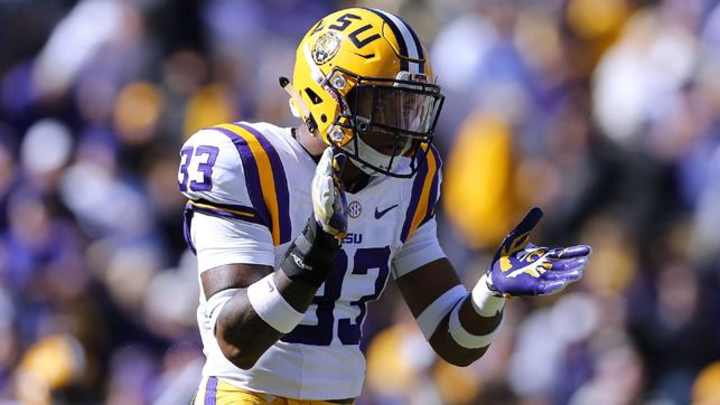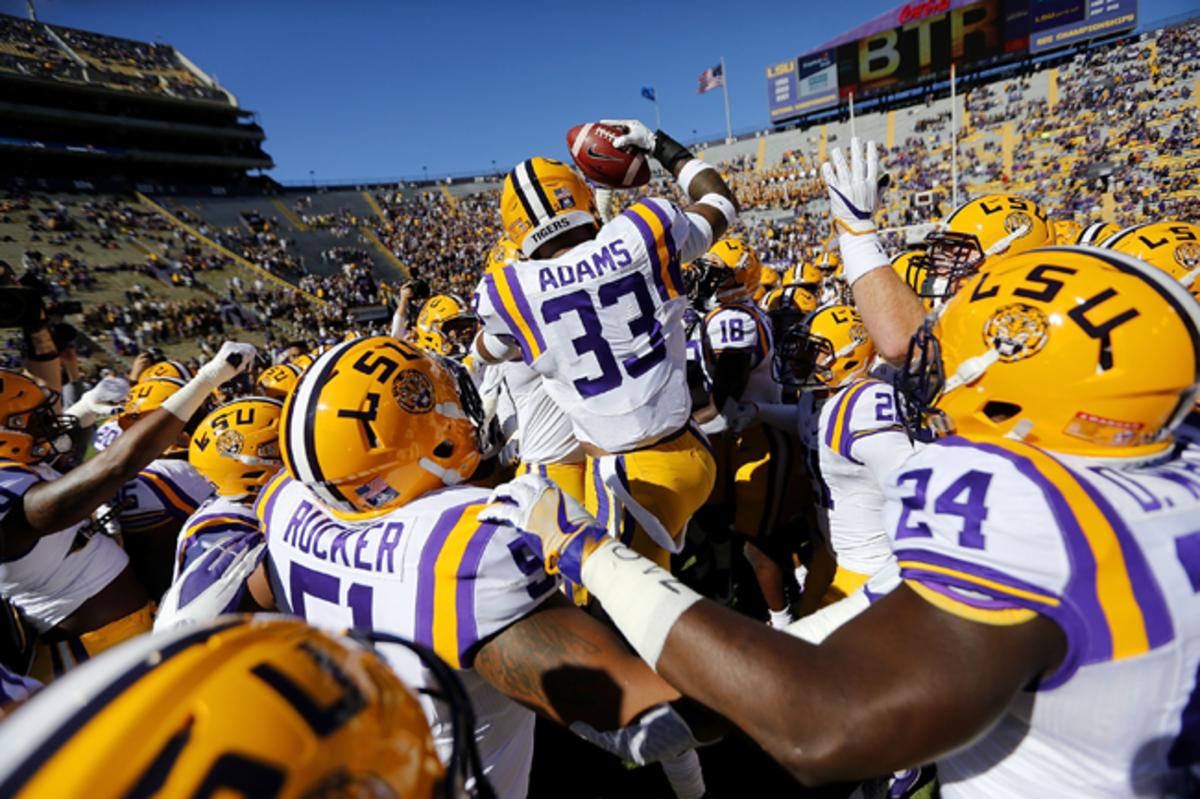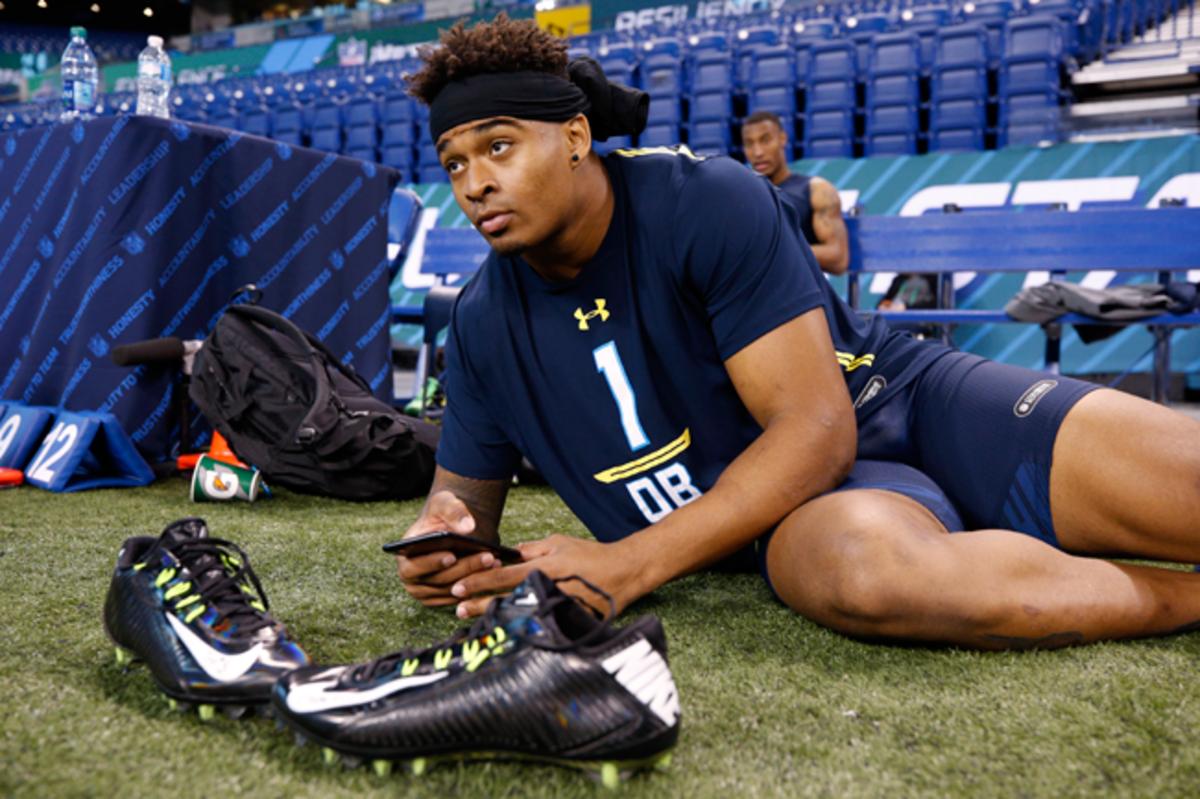Don’t Bring Any Disrespect at Jamal Adams

Jamal Adams was 3 when he first played organized football, but like most preschoolers, he was raw. “My first year I would run the wrong way,” Adams says. “I was also looking at butterflies.” Before you bleat outrage in the name of long-term health, know that he didn’t play tackle football until the strapping age of 5. By then, of course, he was competing in the 8-year-old division.
“My mom was all for it. She supported every game,” Adams says. “That’s just how it is. It wasn’t something I was forced to do . . . I fell in love with the game.”
His mother, Michelle, had spent much of her life around football. In 1991 she married Jamal’s father, George, a first-round pick of the Giants in ’85. Four years after his father’s NFL career ended, Jamal was born in Lewisville, Tex., where he grew up in the football-crazed suburbs of Dallas.
Born into football’s fast lane, Adams sped down it in a luxury car with a full navigation system. Besides having a former NFL running back as a dad, he cites Bill Parcells as a mentor and Michael Irvin is a close family friend. Staying in that fast lane, Adams played as a true freshman at LSU and declared for the draft two years later. He’s likely to be the first safety off this year’s board. And it’ll be a small disappointment if he doesn’t start for his new team in Week 1.

“I think this is what separates me from other cats in this draft,” he says as we watch film of him doing a Charles Woodson impression against Auburn, slithering toward the line of scrimmage to make a swiping tackle. “Film study. Instincts. Just being a football player, just making a play. Not always being a robot.” He plays the tape back. “Coming up, filling the hole. You won’t catch too many [other safeties] that fill the hole.”
We’re in LSU’s defensive meeting room. It is 8 a.m. on a Saturday morning in March. We were scheduled for 11 a.m., but Adams called me the night before and asked to go earlier. He says he likes to get his day going.
Adams studies film the same way he plays: with nonstop energy. Clicker in hand, he alternates from standing to sitting to strolling. He’ll answer a question and, in the same breath, move on to the next play. Watching film with him is like walking a dog that constantly tugs on the leash.
• ANDY BENOIT: Every NFL Team’s Biggest Draft Need
“I wouldn’t want to say that someone is better than me, but Earl Thomas has a lot more experience in the middle of the field, a lot more football IQ,” Adams says when asked who in the NFL right now tops him at playing as a deep, single-high safety. Then, before a follow-up question can be asked, he presses play, bringing the film back to life. “So right here. This is another hell of a play that I make. We’re in a shell call. They motion the X receiver. That means I get to blitz off the edge.”
What jumps off the screen is Adams’s physicality. He’s a textbook tackler, both in traffic and in open space. This stems from tremendous change-of-direction ability and a closing burst. “I pride myself on tackling,” he says. “If I miss a tackle, that eats me alive. That’s almost worse than busting a coverage or giving up a touchdown.”
An opposing player doesn’t need to have the ball to experience Adam’s wrath. On one of the first plays we see, he delivers a fierce, clean shot up high to Auburn receiver Darius Slayton, who was trying to make a block. Then Adams got in Slayton’s grill.
“I simply told him, ‘You can’t block me. You’ll try to block me all game, it’s not going to happen. So just get it out of your head.’ You can tell when the game kept going, he didn’t come in there as hard.”
Adams points at the screen.
“Look—he had to adjust his facemask a little bit.”
We watched several LSU games. In each of them, Adams delivered a high, hard shot to a wide receiver on the receiver’s first blocking attempt of the game.
“I take pride when it comes to a receiver trying to block me—especially a small receiver. I really feel that I should not be blocked by anybody. So for a small receiver to come in and feel like he can block me? It’s disrespectful. If I’m not knocking him on his ass, he damn sure is going to be pushed back.”
Listening to Adams, you naturally become curious about his views on the increased emphasis for player safety.
“It’s football, man,” he says. “What made football was those hits. I remember watching Sean Taylor and Bob Sanders and Brian Dawkins just knock heads. That’s what I love about the game. They’re making it safer, I’m all about making the game safer. At the end of the day, you have to look at it beyond football. But they’ve taken away a little bit of the game. I wish they didn’t take that out. But as a [defensive back] you can still deliver that hit. You just have to lower your target. I adjusted my game when that rule was created.”
• THE 2013 NFL DRAFT: Weird, Strange and Confounding
Enthused as Adams gets about crushing people, what he wants you to know more than anything is that he can cover. Our film session is supposed to last 45 minutes, but it approaches two hours. Adams keeps thinking of more coverage scenarios to show. LSU has a spring practice later in the day. When the team finally needs its defensive meeting room back, Adams takes me upstairs to a position group room. After beckoning a video assistant to help get the computer screen on the large projector, Adams carries on.
He goes through all the forms of coverage assignments he had at LSU, pulling up examples. We see zone from a strong safety spot. Man coverage out of the same look. Help-coverage from free safety. Iso-coverage against a tight end split out wide. Man-to-man in the slot.
“I love it,” he says. “For some reason, certain people want to knock me for my coverage. I gave up one ball over 20 yards”—he’s talking about the Louisville game—“and a lot of people knocked me for my coverage. So when I hear somebody say, ‘He’s a box safety, his coverage ability is not great,’ that just triggers me. It’s like, are you really doing your job to where you’re watching film? You can ask any coach here. That’s what separates me from the pack.”

Adams, the unequivocal leader of LSU’s defense, oozes confidence, but he’s not arrogant. He owns his mistakes. “That’s the one I busted,” he says, recognizing a formation that Auburn will use to complete a wheel route. “So right here, it’s just eye control. I had bad eyes. The linebacker and I had a lack of communication. That’s my route [responsibility] up the field. If there’s one play I’d want back from that game, it’d be that one.”
The highest any safety has been drafted over the last four years was 14th overall (Karl Joseph, by the Raiders in 2016). Don’t be surprised if Adams goes in the top five. As the most rapidly evolving position in pro football, a safety is more valuable than ever. Eric Berry just set the market with his new six-year deal in Kansas City, worth $40 million guaranteed. Tyrann Mathieu, if he stays healthy in 2017, will stay with the Cardinals in a contract worth $40 million guaranteed. Mathieu’s former teammate, Tony Jefferson, just signed with the Ravens for $9 million a year, after turning down $10.5 million a year from the Browns. Overall, the top salaries for safeties since 2013 have grown more than any defensive position except for defensive tackle.
A big reason for the safety’s rise: the position drives a scheme’s versatility. Every coverage disguise involves a safety. So do many blitzes. As the one guy the offense usually doesn’t have a blocker for, the safety is also integral in run defense. And, perhaps most importantly, he’s the answer to the flexible tight ends who line up all over the field. This is why Adams is adamant that his coverage prowess be known. He’s comfortable guarding tight ends anywhere, and matchups against the elite ones can’t come soon enough.
“In the NFL nowadays, tight ends are evolving to where they’re receivers,” Adams says. “But in college, literally, I told my coach that tight ends were getting boring to cover. It was so naturally easy, I was getting bored out there. And these are my guys, so don’t get me wrong—but [Alabama’s] O.J. Howard, [Ole Miss’s] Evan Engram, those guys combined for like four catches on me total.”
Adams’s favorite place to play is the slot. Which is important because NFL offenses now operate with three receivers on a majority of snaps. Many of those snaps come on first and second down, when the running game is still an option. To counter, defenses are starting to use three safeties. Having a safety who can cover the slot creates tremendous flexibility. (Ask the Eagles about Malcolm Jenkins, or the Cowboys about Byron Jones.)
Just when you think Adams might be superhuman (at least by Jamal Adams’s estimation), the topic of playing linebacker comes up. Finally, there’s one area where he can’t pull up proof from his film.
“I feel like I can play anywhere on the field. But linebacker? Yeah, I’m not gonna . . .” He trails off and then restarts with a soft chuckle. “When I say I like to get dirty, that doesn’t mean I want to, you know, be involved when it comes to these offensive linemen. I dip under linemen, I don’t try to take on too many. Linemen nowadays are huge. You gotta know your place. So when it comes to linebacker, nah, you can have that. But now if you ask me to do it”—he pauses just long enough to let acceptance enter his voice—“then yeah I’ll do it.”

• Question? Comment? Story idea? Let us know at talkback@themmqb.com
